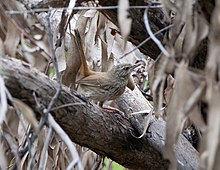Chestnut-rumped heathwren
| Chestnut-rumped heathwren | |
|---|---|

| |
| Scientific classification | |
| Domain: | Eukaryota |
| Kingdom: | Animalia |
| Phylum: | Chordata |
| Class: | Aves |
| Order: | Passeriformes |
| Family: | Acanthizidae |
| Genus: | Hylacola |
| Species: | H. pyrrhopygia
|
| Binomial name | |
| Hylacola pyrrhopygia | |
| Subspecies[2] | |
| |
| Synonyms | |
| |
The chestnut-rumped heathwren (Hylacola pyrrhopygia) is a species of bird in the family Acanthizidae. It is endemic to temperate and subtropical forests and heathlands of Australia.
Taxonomy
The chestnut-rumped heathwren was first described by the Irish zoologist Nicholas Aylward Vigors and the American physician and naturalist Thomas Horsfield in 1827. The generic name Hylacola derives from the Greek hylē 'woodland' and the Latin -cola 'dweller'.[3] The specific epithet pyrrhopygia derives from Greek pyrrhos 'flame-coloured, red' and pyge 'rump'.[3] It is also known colloquially as the scrub warbler.[4] There are three subspecies: Hylacola pyrrhopygia pyrrhopygia in New South Wales and Victoria; H. p. parkeri in the
Description
The chestnut-rumped heathwren is a small bushland bird with an olive-brown back with conspicuous reddish-brown rump and tail coverts.[6] It has a streaked brown-on-white chest and the belly and rear flanks are grey-buff.[7] There is a dark subterminal band with a white tip on the usually erect tail.[6] Both sexes have a dull white eyebrow; eyes are yellow, while bill, legs, and feet are grey.[8] There are only small differences between the subspecies that are not easily recognised in the field. It measures 14 cm (5.5 in) in length.[9]
Distribution and habitat
The chestnut-rumped heathwren occurs in southeastern Australia from the
Behaviour and breeding
The chestnut-rumped heathwren is usually shy and secretive until the breeding season from July to November, when both sexes will sing from a perch on a bush, though still staying partly concealed.[7] Its song is a rich, melodious warbling chi-chi-tu-weet, kwe-reep, and suchlike notes in great variety, blended with mimicry of other birds.[7][11][4][5] It also makes a harsh or scolding zeet on contact or alarm.[4] The chestnut-rumped heathwren builds a domed or globular nest on or near the ground in tussocks or dense shrubs.[4] The nest is composed of dry grass stems, bark fibre and rootlets, often appearing untidy.[4] A clutch of three or four eggs is laid and usually incubated by the female for 14-16 days.[7][5] The eggs, measuring 20 by 15 mm (0.79 by 0.59 in), are salmon-pink, freckled with light chocolate-brown, more so at the larger end.[4][7]
Diet and foraging
The chestnut-rumped heathwren forages singly, in pairs or small parties, occasionally with
Conservation
Although the population of chestnut heathwrens is declining,
References
- ^ .
- ^ Gill F, D Donsker & P Rasmussen (Eds). 2020. IOC World Bird List (v10.2). doi : 10.14344/IOC.ML.10.2.
- ^ a b Jobling, James A. "Helm Dictionary of Scientific Bird-names". Retrieved 2020-04-18.
- ^ ISBN 073222436-5
- ^ a b c d e f Gregory, P. (2020). "Chestnut-rumped Heathwren (Hylacola pyrrhopygia), version 1.0." In Birds of the World (J. del Hoyo, A. Elliott, J. Sargatal, D. A. Christie, and E. de Juana, Editors). Cornell Lab of Ornithology, Ithaca, NY, USA. https://doi.org/10.2173/bow.chrhea1.01
- ^ ISBN 067087918-5.
- ^ ISBN 978174021417-9
- ^ "Chestnut-rumped Heathwren". Mdahlem.net.
- ISBN 978-0-691-15727-6.
- ^ "Birdata map:chestnut-rumped heathwren". Retrieved 2020-04-17.
- ^ ISBN 085179813-6
- ^ "Threatened Species Profile:Chestnut-rumped Heathwren (Mount Lofty Ranges)" (PDF). Natural Resources: Adelaide and Mt Lofty Ranges.
- ISBN 978-1-74208-039-0.

